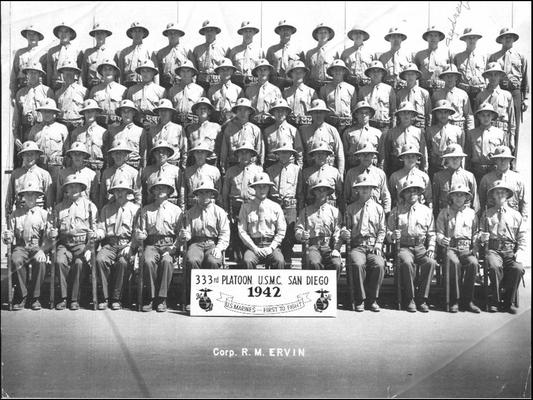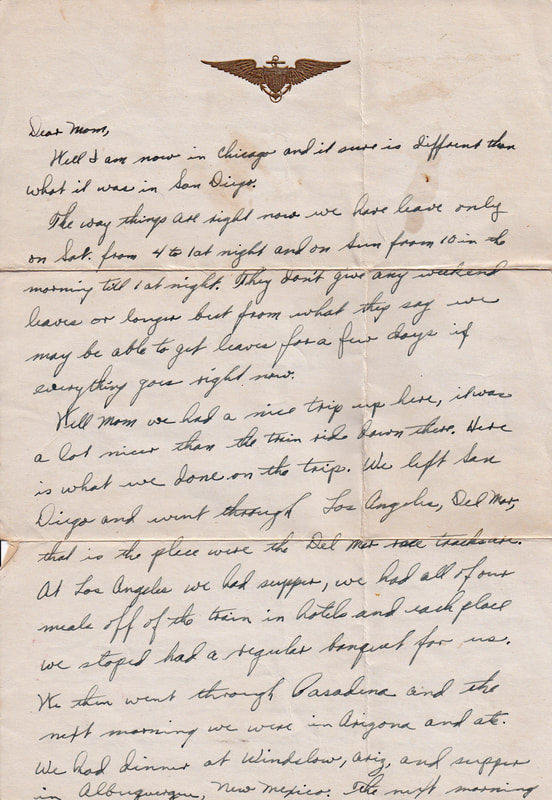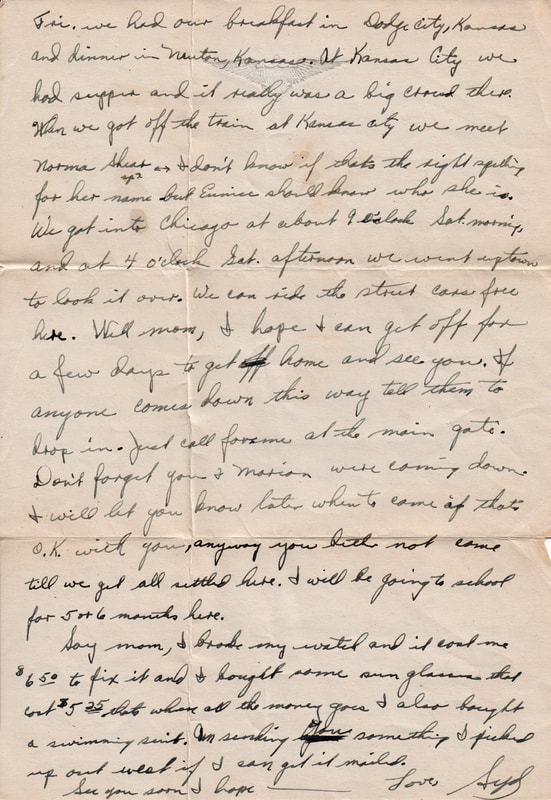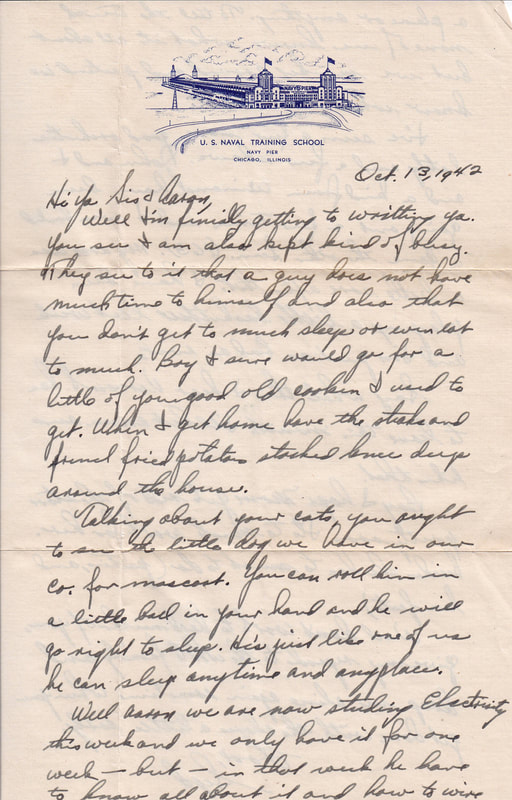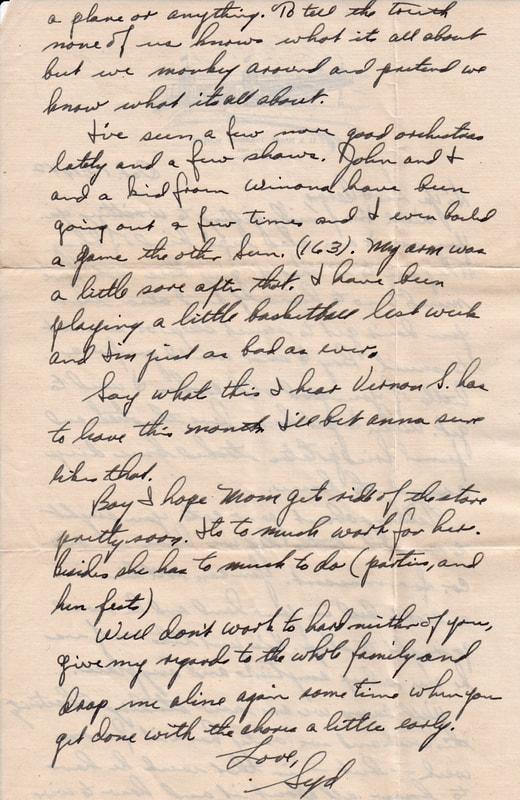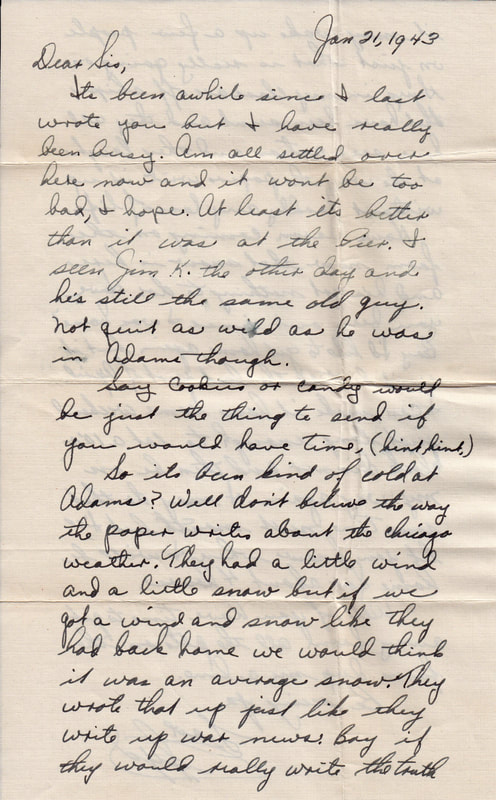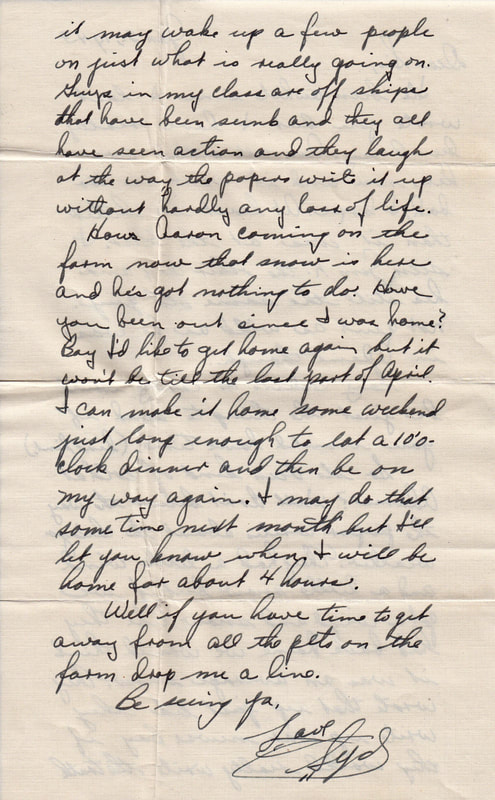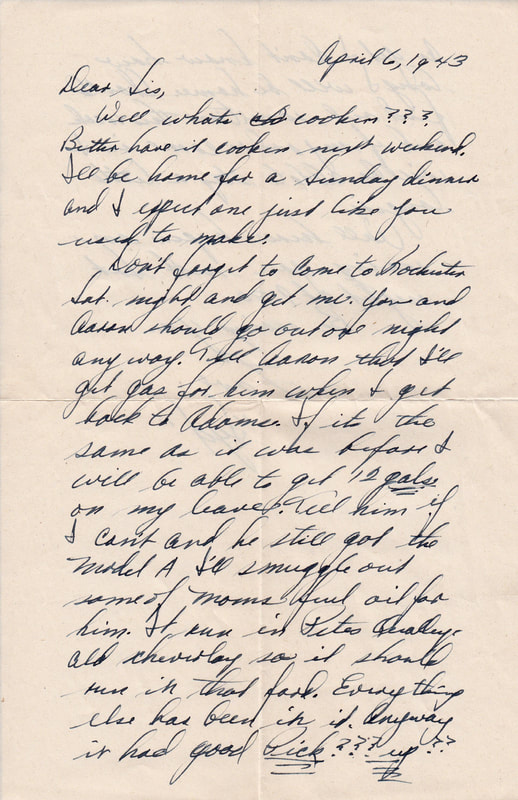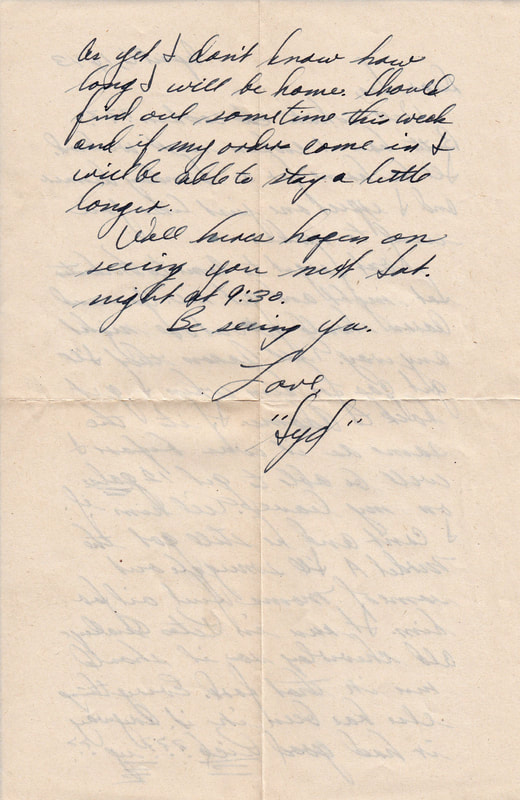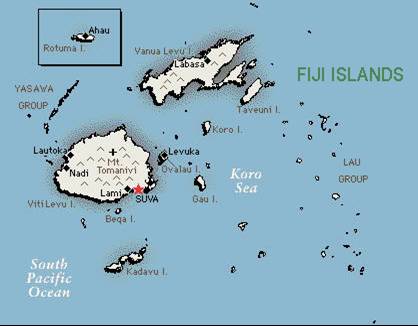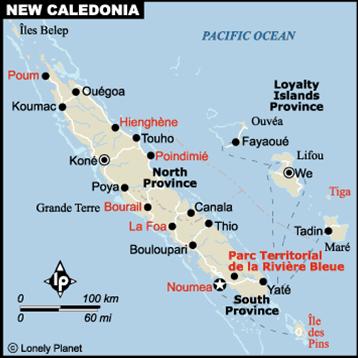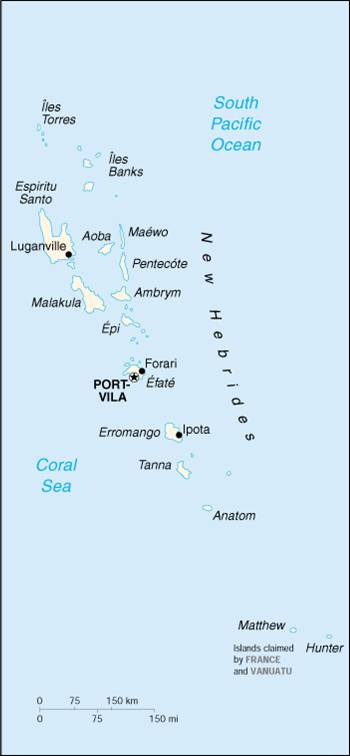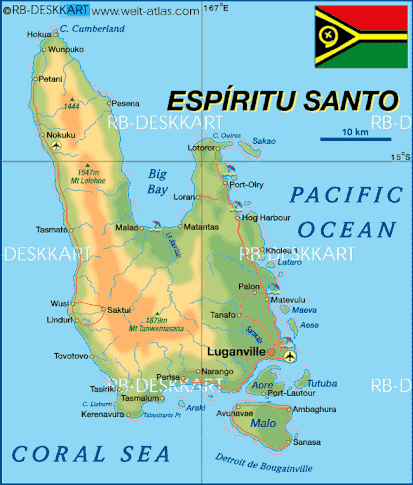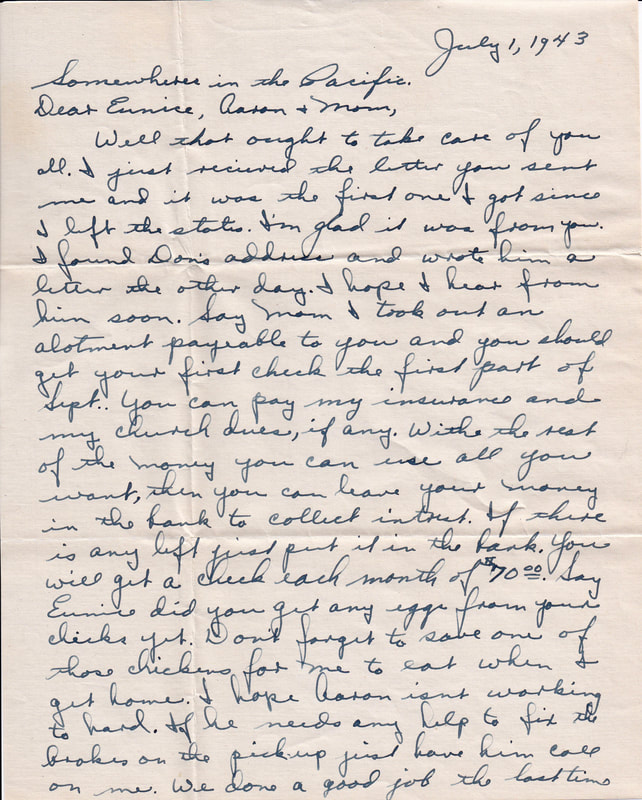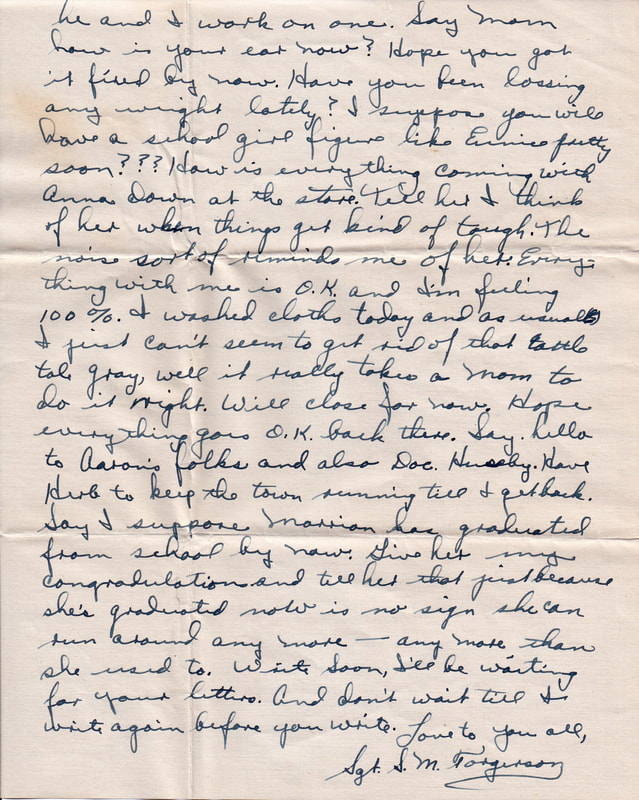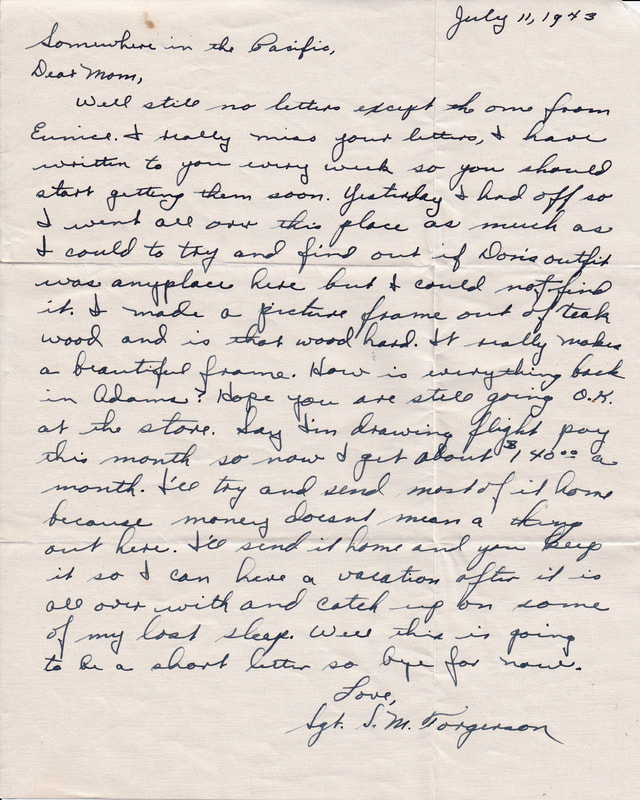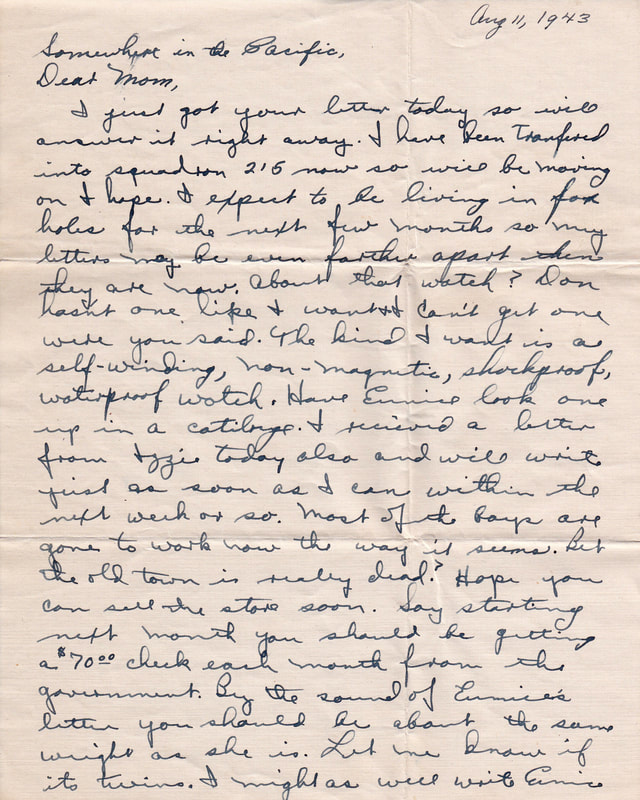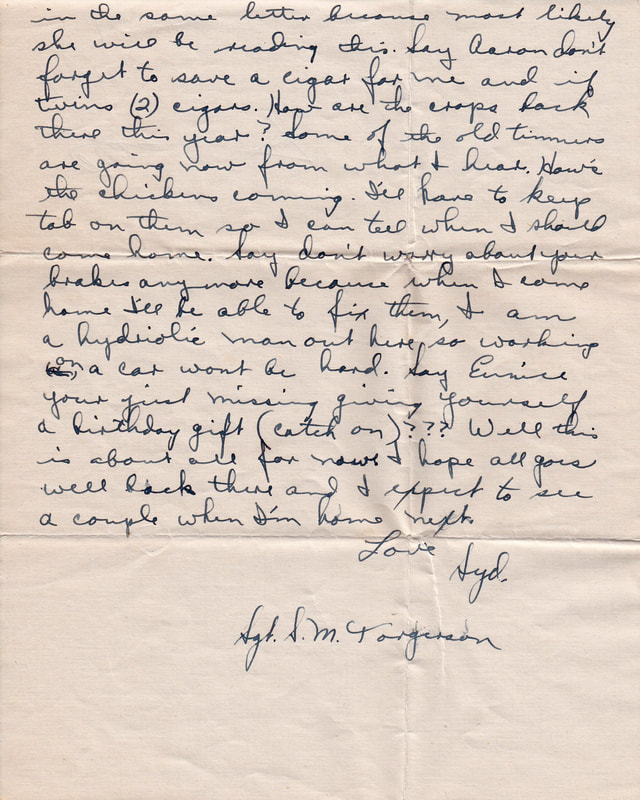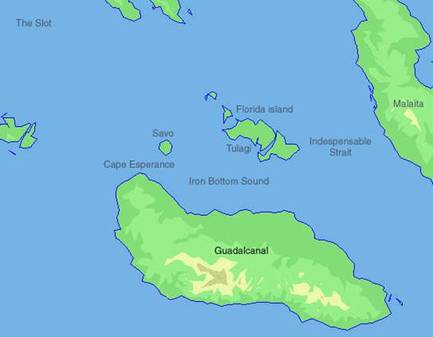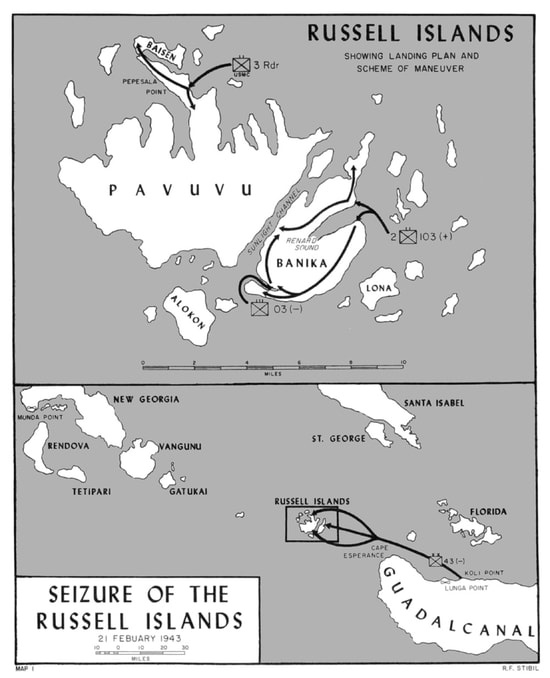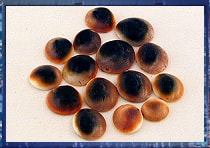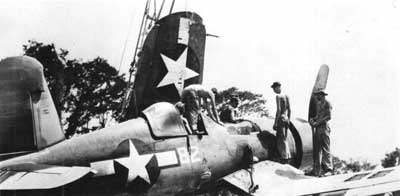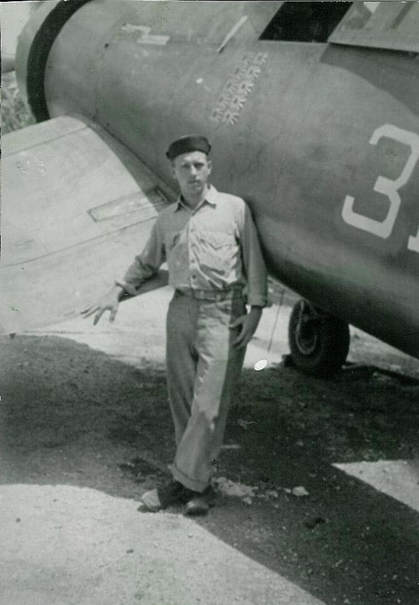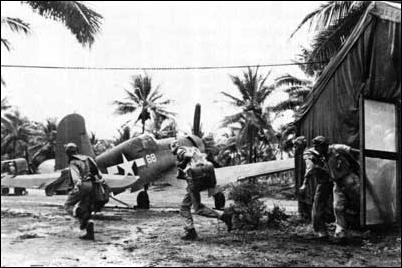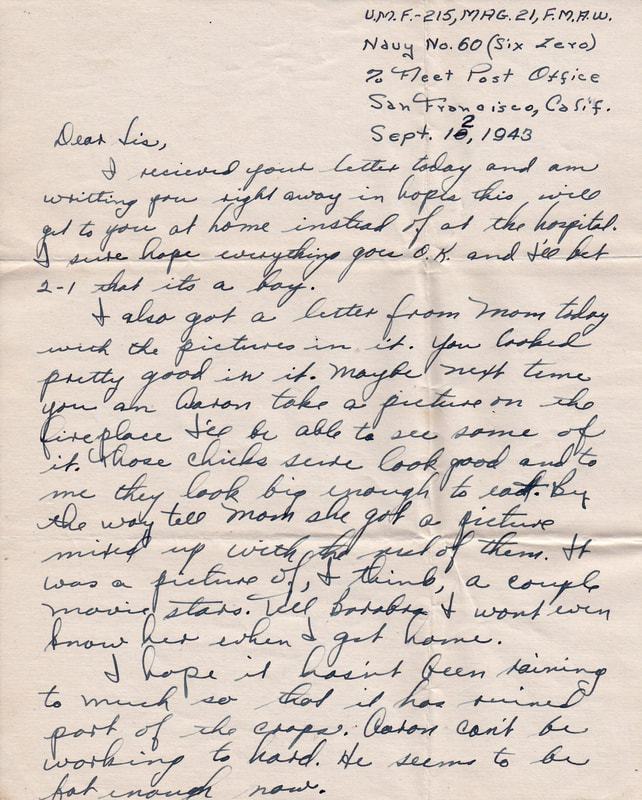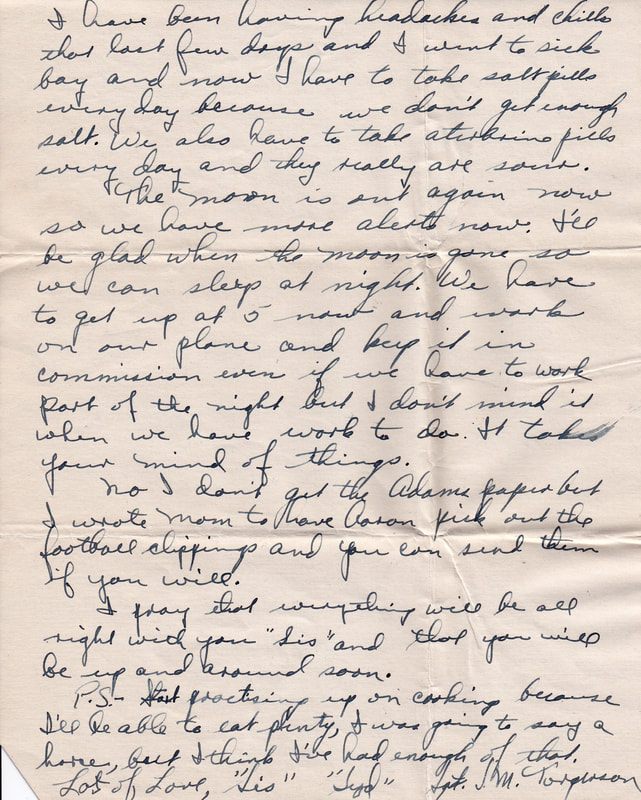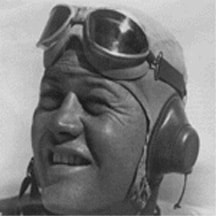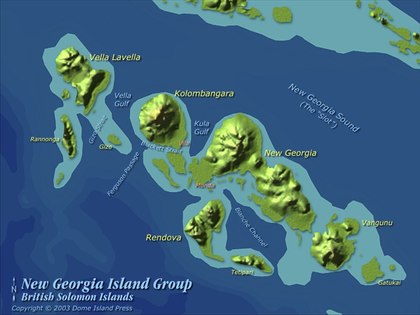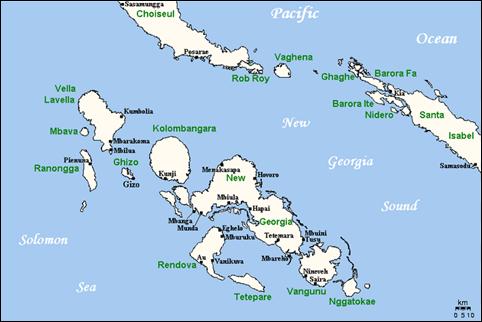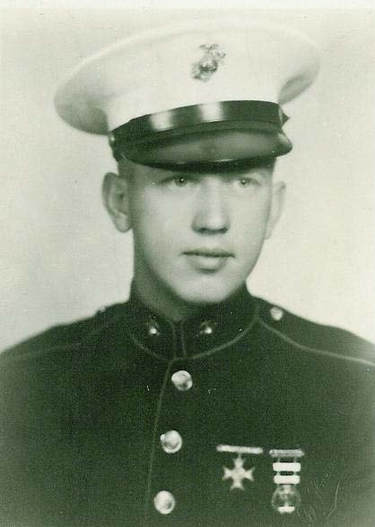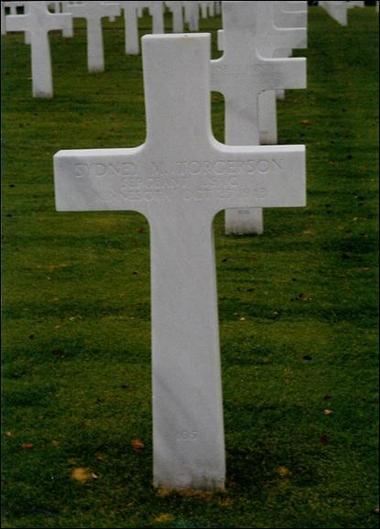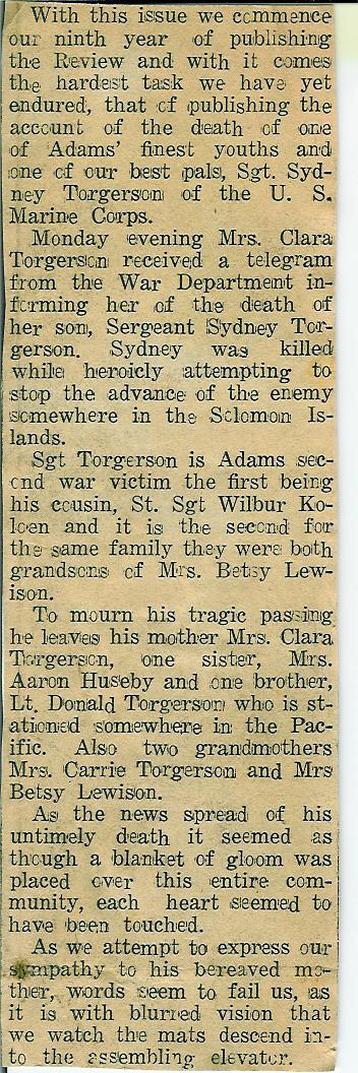Sergeant Sydney Torgerson WWII Journal
“The first counterattacks against the Japanese were initiated in the jungled Solomons, part of the fiery, volcanic rim of the Pacific, where forces under Vice Admiral William Halsey pushed up the slot from bloody, muddy Guadalcanal to Empress Augusta Bay. During this offensive, which spanned more than a year – from August 1942 until November 1943 – some of the fiercest naval battles of the war were fought. The green hell of the Solomons will also be long remembered by the Marine and Army troops who completely shattered the myth of the invincibility of the Japanese soldier.”
– From The Battle Report: Victory in the Pacific
This is the WWII Journal of Sergeant Sydney Marvin Torgerson written when he was in the United States Marine Corp, 1942-1943. Syd was stationed at: Marine Base, San Diego, California; Navy Pier, Chicago, Illinois; 87th Street, Chicago, Illinois; North Island, San Diego, California; Camp Kerney Messa, San Diego, California; Fiji Islands; New Caledonia Island; New Hebrides Island; Guadalcanal Island; Russell Island; Munda Island; and Andonga Island. Personal letters (with transcriptions) from Syd have been added to the diary.*Italicized text is what I have added to the original diary.
April 2, 1942
Joined the United States Marine Corp and went through training at San Diego.
– From The Battle Report: Victory in the Pacific
This is the WWII Journal of Sergeant Sydney Marvin Torgerson written when he was in the United States Marine Corp, 1942-1943. Syd was stationed at: Marine Base, San Diego, California; Navy Pier, Chicago, Illinois; 87th Street, Chicago, Illinois; North Island, San Diego, California; Camp Kerney Messa, San Diego, California; Fiji Islands; New Caledonia Island; New Hebrides Island; Guadalcanal Island; Russell Island; Munda Island; and Andonga Island. Personal letters (with transcriptions) from Syd have been added to the diary.*Italicized text is what I have added to the original diary.
April 2, 1942
Joined the United States Marine Corp and went through training at San Diego.
June 1942
Went to Chicago, Illinois, for 6 months of A.M.M. school. *I’m not sure what A.M.M. stands for.
Went to Chicago, Illinois, for 6 months of A.M.M. school. *I’m not sure what A.M.M. stands for.
Dear Mom,
Well I am now in Chicago and it sure is different than what it was in San Diego.
The way things are right now we have leave only on Sat. from 4 to 1 at night and on Sun. from 10 in the morning till 1 at night. They don’t give any weekend leaves or longer but from what they say we may be able to get leaves for a few days if everything goes right now.
Well Mom, we had a nice trip up here. It was a lot nicer than the train ride down there. Here is what we done on the trip. We left San Diego and went through Los Angeles, Del Mar, that is the place where the Del Mar race tracks are. At Los Angeles we had supper, we had all of our meals off of the train in hotels and each place we stopped had a regular banquet for us. We then went through Pasadena and the next morning we were in Arizona and ate. We had dinner at Winslow, Ariz., and supper in Albuquerque, New Mexico. The next morning Fri. we had our breakfast in Dodge City, Kansas and dinner in Newton, Kansas. At Kansas Cty we had supper and it really was a big crowd there. When we got off the train at Kansas City we met Norma Shear – I don’t know if that’s the right spelling for her name but Eunice should know who she is. We got into Chicago at about 2 o’clock Sat. Morning, and at 4 o’clock Sat. afternoon we went uptown to look it over. We can ride the street cars free here. Well mom, I hope I can get off for a few days to get home and see you. If anyone comes down this way tell them to drop in. Just call for me at the main gate.
Don’t forget you and Marion were coming down and will let you know later when to come if that’s O. K. with you, anyway you better not come till we get all settled here. I will be going to school for 5 or 6 months here.
Say mom, I broke my watch and it cost me $6.50 to fix it and I bought some sunglasses that cost $5.25 that’s where all the money goes. I also bought a swimming suit. I’m sending you something I picked up out west if I can get it mailed.
See you soon I hope.
Love, Syd
Well I am now in Chicago and it sure is different than what it was in San Diego.
The way things are right now we have leave only on Sat. from 4 to 1 at night and on Sun. from 10 in the morning till 1 at night. They don’t give any weekend leaves or longer but from what they say we may be able to get leaves for a few days if everything goes right now.
Well Mom, we had a nice trip up here. It was a lot nicer than the train ride down there. Here is what we done on the trip. We left San Diego and went through Los Angeles, Del Mar, that is the place where the Del Mar race tracks are. At Los Angeles we had supper, we had all of our meals off of the train in hotels and each place we stopped had a regular banquet for us. We then went through Pasadena and the next morning we were in Arizona and ate. We had dinner at Winslow, Ariz., and supper in Albuquerque, New Mexico. The next morning Fri. we had our breakfast in Dodge City, Kansas and dinner in Newton, Kansas. At Kansas Cty we had supper and it really was a big crowd there. When we got off the train at Kansas City we met Norma Shear – I don’t know if that’s the right spelling for her name but Eunice should know who she is. We got into Chicago at about 2 o’clock Sat. Morning, and at 4 o’clock Sat. afternoon we went uptown to look it over. We can ride the street cars free here. Well mom, I hope I can get off for a few days to get home and see you. If anyone comes down this way tell them to drop in. Just call for me at the main gate.
Don’t forget you and Marion were coming down and will let you know later when to come if that’s O. K. with you, anyway you better not come till we get all settled here. I will be going to school for 5 or 6 months here.
Say mom, I broke my watch and it cost me $6.50 to fix it and I bought some sunglasses that cost $5.25 that’s where all the money goes. I also bought a swimming suit. I’m sending you something I picked up out west if I can get it mailed.
See you soon I hope.
Love, Syd
October 13, 1942 - Letter from Syd to Eunice and Aaron
Hi Ya Sis and Aaron,
Well I’m finally getting to writing ya. You see I am also kept kind of busy. They see to it that a guy does not have much time to himself and also that you don’t get too much sleep or even eat too much. Boy I sure would go for a little of your good old cooking I used to get. When I get home have the steaks and French fried potatoes stacked knee deep around the house.
Talking about your eats you ought to see the little dog we have in our co. for mascot. You can roll him in a little ball in your hand and he will go right to sleep. He’s just like one of us he can sleep anytime and anyplace.
Well Aaron we are now studying electricity this week and we only have it for one week – but – in that week we have to know all about it and how to wire a plane or anything. To tell the truth none of us knows what it’s all about but we monkey around and pretend we know what it’s all about.
I’ve seen a few more good orchestras lately and a few shows. John and I and a kid from Winona have been going out a few times and I even bowled a game the other Sun. (163). My arm was a little sore after that. I have been playing a little basketball last week and I’m just as bad as ever.
Say what this I hear Vernon S. has to leave this month. I’ll bet Anna sure liked that.
Boy I hope Mom gets rid of the store pretty soon. It’s too much work for her. Besides she has too much to do (parties, and hen fests)
Well don’t work too hard either of you, give my regards to the whole family and drop me a line again sometime when you get done with the chores a little early.
Love, Syd
January 2, 1943
Graduated from A.M.M. school and went to advanced aviation school at 81st and Anthony at Chicago for 4 months of a propeller course.
January 21, 1943 - Letter from Syd to Eunice
Well I’m finally getting to writing ya. You see I am also kept kind of busy. They see to it that a guy does not have much time to himself and also that you don’t get too much sleep or even eat too much. Boy I sure would go for a little of your good old cooking I used to get. When I get home have the steaks and French fried potatoes stacked knee deep around the house.
Talking about your eats you ought to see the little dog we have in our co. for mascot. You can roll him in a little ball in your hand and he will go right to sleep. He’s just like one of us he can sleep anytime and anyplace.
Well Aaron we are now studying electricity this week and we only have it for one week – but – in that week we have to know all about it and how to wire a plane or anything. To tell the truth none of us knows what it’s all about but we monkey around and pretend we know what it’s all about.
I’ve seen a few more good orchestras lately and a few shows. John and I and a kid from Winona have been going out a few times and I even bowled a game the other Sun. (163). My arm was a little sore after that. I have been playing a little basketball last week and I’m just as bad as ever.
Say what this I hear Vernon S. has to leave this month. I’ll bet Anna sure liked that.
Boy I hope Mom gets rid of the store pretty soon. It’s too much work for her. Besides she has too much to do (parties, and hen fests)
Well don’t work too hard either of you, give my regards to the whole family and drop me a line again sometime when you get done with the chores a little early.
Love, Syd
January 2, 1943
Graduated from A.M.M. school and went to advanced aviation school at 81st and Anthony at Chicago for 4 months of a propeller course.
January 21, 1943 - Letter from Syd to Eunice
Dear Sis,
It’s been awhile since I last wrote you but I have really been busy. Am all settled over here now and it won’t be too bad, I hope. At least it’s better than it was at the Pier. I seen Jim K. the other day and he’s still the same old guy. Not quite as wild as he was in Adams, though.
Boy, cookies or candy would be just the thing to send if you would have time, (hint, hint).
So it’s been kind of cold at Adams? Well don’t believe the way the paper writes about the Chicago weather. They had a little wind and a little snow but if we got a wind and snow like they had back home we would think it was an average snow. They wrote that up just like they write up war news. Boy if they would really write the truth it may wake up a few people on just what is really going on. Guys in my class are off ships that have been sunk and they all have seen action and they laugh at the way the papers write it up without hardly any loss of life.
How’s Aaron coming on the farm now that snow is here and he’s got nothing to do. Have you been out since I was home? Boy I’d like to get home again but it won’t be till the last part of April. I can make it home some weekend just long enough to eat a 10’oclock dinner and then be on my way again. I may do that sometime next month but I’ll let you know when I will be home for about 4 hours.
Well if you have time to get away from all the pets on the farm drop me a line.
Be seeing ya,
Love, Syd
April 6, 1943 - Letter from Syd to Eunice
It’s been awhile since I last wrote you but I have really been busy. Am all settled over here now and it won’t be too bad, I hope. At least it’s better than it was at the Pier. I seen Jim K. the other day and he’s still the same old guy. Not quite as wild as he was in Adams, though.
Boy, cookies or candy would be just the thing to send if you would have time, (hint, hint).
So it’s been kind of cold at Adams? Well don’t believe the way the paper writes about the Chicago weather. They had a little wind and a little snow but if we got a wind and snow like they had back home we would think it was an average snow. They wrote that up just like they write up war news. Boy if they would really write the truth it may wake up a few people on just what is really going on. Guys in my class are off ships that have been sunk and they all have seen action and they laugh at the way the papers write it up without hardly any loss of life.
How’s Aaron coming on the farm now that snow is here and he’s got nothing to do. Have you been out since I was home? Boy I’d like to get home again but it won’t be till the last part of April. I can make it home some weekend just long enough to eat a 10’oclock dinner and then be on my way again. I may do that sometime next month but I’ll let you know when I will be home for about 4 hours.
Well if you have time to get away from all the pets on the farm drop me a line.
Be seeing ya,
Love, Syd
April 6, 1943 - Letter from Syd to Eunice
Dear Sis,
Well what’s cooking??? Better have it cooking next weekend. I’ll be home for a Sunday dinner and I expect one just like you used to make.
Don’t forget to come to Rochester Sat. night and get me. You and Aaron should go out one night anyway. Tell Aaron that I’ll get gas for him when I get back to Adams. If it’s the same as it was before I will be able to get 12 gals. On my leave. Tell him if I can’t and he still got the Model A I’ll smuggle out some of Mom’s fuel oil for him. It run in Pete Qualley’s old Chevrolet so it should run in that Ford. Everything else has been in it. Anyway it had good Pick???up??
As yet I don’t know how long I will be home. Should find out sometime this week and if my orders come in I will be able to stay a little longer.
Well here’s hopen (sic) on seeing you next Sat night at 9:30.
Be seeing ya.
Love, “Syd”
Well what’s cooking??? Better have it cooking next weekend. I’ll be home for a Sunday dinner and I expect one just like you used to make.
Don’t forget to come to Rochester Sat. night and get me. You and Aaron should go out one night anyway. Tell Aaron that I’ll get gas for him when I get back to Adams. If it’s the same as it was before I will be able to get 12 gals. On my leave. Tell him if I can’t and he still got the Model A I’ll smuggle out some of Mom’s fuel oil for him. It run in Pete Qualley’s old Chevrolet so it should run in that Ford. Everything else has been in it. Anyway it had good Pick???up??
As yet I don’t know how long I will be home. Should find out sometime this week and if my orders come in I will be able to stay a little longer.
Well here’s hopen (sic) on seeing you next Sat night at 9:30.
Be seeing ya.
Love, “Syd”
April 10, 1943
Graduated from Prop. School with Sgt. Rating. Went to Kerney Messa, San Diego, California to wait further orders.
May 20, 1943
Left San Diego for overseas duty. Sailed on a Dutch ship called the “Sommellsdykj”.
May 29, 1943
Went over the equator and had a real initiation. Am now a full fledged “shell back”* *Anyone who has crossed the equator by ship.
June 8, 1943
Stopped at the Fiji Islands for 2 days. Was fishing for jellyfish while there.
Graduated from Prop. School with Sgt. Rating. Went to Kerney Messa, San Diego, California to wait further orders.
May 20, 1943
Left San Diego for overseas duty. Sailed on a Dutch ship called the “Sommellsdykj”.
May 29, 1943
Went over the equator and had a real initiation. Am now a full fledged “shell back”* *Anyone who has crossed the equator by ship.
June 8, 1943
Stopped at the Fiji Islands for 2 days. Was fishing for jellyfish while there.
June 10, 1943
Left for New Caledonia and was stationed there for 3 days to wait further orders.
Left for New Caledonia and was stationed there for 3 days to wait further orders.
June 18, 1943
Arrived in New Hebrides and was put in squadron 112; called the “Wolf Pack” in Mag. 11. *See website for VMF-112 Wolf Pack
Arrived in New Hebrides and was put in squadron 112; called the “Wolf Pack” in Mag. 11. *See website for VMF-112 Wolf Pack
June 27, 1943
Had an earthquake that really was a shaker. While on the Island groups of New Hebrides I was stationed on the island of “Esprita Santous” (sic: Espiritu Santo) on Fighter Strip no. 1. We had all F4U’s in our squadron.
Had an earthquake that really was a shaker. While on the Island groups of New Hebrides I was stationed on the island of “Esprita Santous” (sic: Espiritu Santo) on Fighter Strip no. 1. We had all F4U’s in our squadron.
July 1, 1943 - Letter from Syd to Eunice, Aaron, and Clara
Somewhere in the Pacific.
Dear Eunice, Aaron and Mom,
Well that ought to take care of you all. I just received the letter you sent me and it was the first one I got since I left the States. I’m glad it was from you. I found Don’s address and wrote him a letter the other day. I hope I hear from him soon. Say Mom I took out an allotment payable to you and you should get your first check the first part of Sept. You can pay my insurance and my church dues, if any. With the rest of the money you can use all you want, then you can leave your money in the bank to collect interest. If there is any left just put it in the bank. You will get a check each month of $70.00. Say Eunice did you get any eggs from your chicks yet. Don’t forget to save one of those chickens for me to eat when I get home. I hope Aaron isn’t working too hard. If he needs any help to fix the brakes on the pickup just have him call on me. We done a good job the last time he and I worked on one. Say Mom how is your ear now? Hope you got it fixed by now. Have you been losing any weight lately? I suppose you will have a school girl figure like Eunice pretty soon??? How is everything coming with Anna down at the store. Tell her I think of her when things get kind of tough. The noise sort of reminds me of her. Everything with me is O. K. and I’m feeling 100%. I washed clothes today and as usual I just can’t seem to get rid of that tattletale gray, well it really takes a Mom to do it right. Will close for now. Hope everything goes O. K. Back there. Say hello to Aaron’s folks and also Doc Huseby. Have Herb to keep the town running till I get back. Say I suppose Marion has graduated from school by now. Give her my congratulations and tell her that just because she’s graduated now is no sign she can run around anymore – anymore than she used to. Write soon. I’ll be waiting for your letters. And don’t wait till I write again before you write.
Love to you all,
Sgt. S. M. Torgerson
Dear Eunice, Aaron and Mom,
Well that ought to take care of you all. I just received the letter you sent me and it was the first one I got since I left the States. I’m glad it was from you. I found Don’s address and wrote him a letter the other day. I hope I hear from him soon. Say Mom I took out an allotment payable to you and you should get your first check the first part of Sept. You can pay my insurance and my church dues, if any. With the rest of the money you can use all you want, then you can leave your money in the bank to collect interest. If there is any left just put it in the bank. You will get a check each month of $70.00. Say Eunice did you get any eggs from your chicks yet. Don’t forget to save one of those chickens for me to eat when I get home. I hope Aaron isn’t working too hard. If he needs any help to fix the brakes on the pickup just have him call on me. We done a good job the last time he and I worked on one. Say Mom how is your ear now? Hope you got it fixed by now. Have you been losing any weight lately? I suppose you will have a school girl figure like Eunice pretty soon??? How is everything coming with Anna down at the store. Tell her I think of her when things get kind of tough. The noise sort of reminds me of her. Everything with me is O. K. and I’m feeling 100%. I washed clothes today and as usual I just can’t seem to get rid of that tattletale gray, well it really takes a Mom to do it right. Will close for now. Hope everything goes O. K. Back there. Say hello to Aaron’s folks and also Doc Huseby. Have Herb to keep the town running till I get back. Say I suppose Marion has graduated from school by now. Give her my congratulations and tell her that just because she’s graduated now is no sign she can run around anymore – anymore than she used to. Write soon. I’ll be waiting for your letters. And don’t wait till I write again before you write.
Love to you all,
Sgt. S. M. Torgerson
July 11, 1943 - Letter from Syd to Clara
Somewhere in the Pacific.
Dear Mom,
Well still no letter except the one from Eunice. I really miss your letters, I have written to you every week so you should start getting them soon. Yesterday I had off so I went all over this place as much as I could to try and find out if Don’s outfit was anyplace here, but I could not find it. I made a picture frame out of teak wood and is that wood hard. It really makes a beautiful frame. How is everything back in Adams? Hope you are still going O.K. at the store. Say I’m drawing flight pay this month so now I get about $140.00 a month. I’ll try and send most of it home because money doesn’t mean a thing out here. I’ll send it home and you keep it so I can have a vacation after it is all over with and catch up on some of my lost sleep. Well this is going to be a short letter so by for now.
Love,
Sgt. S. M. Torgerson
Dear Mom,
Well still no letter except the one from Eunice. I really miss your letters, I have written to you every week so you should start getting them soon. Yesterday I had off so I went all over this place as much as I could to try and find out if Don’s outfit was anyplace here, but I could not find it. I made a picture frame out of teak wood and is that wood hard. It really makes a beautiful frame. How is everything back in Adams? Hope you are still going O.K. at the store. Say I’m drawing flight pay this month so now I get about $140.00 a month. I’ll try and send most of it home because money doesn’t mean a thing out here. I’ll send it home and you keep it so I can have a vacation after it is all over with and catch up on some of my lost sleep. Well this is going to be a short letter so by for now.
Love,
Sgt. S. M. Torgerson
August 11, 1943 - Letter from Syd to Clara
Somewhere in the Pacific,
Dear Mom,
I just got your letter today so will answer it right away. I have been transferred into squadron 215 now so will be moving on I hope. I expect to be living in fox holes for the next few months so my letters may be even farther apart then they are now. About that watch? Don hasn’t one like I want and I can’t get one where you said. The kind I want is a self-winding, non-magnetic, shock proof, waterproof watch. Have Eunice look one up in a catalogue. I received a letter from Izzie today also and will write just as soon as I can within the next week or so. Most of the boys are gone to work now the way it seems. Bet the old town is really dead? Hope you can sell the store soon. Say starting next month you should be getting a $70.00 check each month from the government. By the sound of Eunice’s letter you should be about the same weight as she is. Let me know if it’s twins. I might as well write Eunice in the same letter because most likely she will be reading this. Say Aaron don’t forget to save a cigar for me and if twins (2) cigars. How are the crops back there this year? Some of the old timers are going home from what I hear. How’s the chickens coming. I’ll have to keep tabs on them so I can tell when I should come home. Say don’t worry about your brakes anymore because when I come home I’ll be able to fix them, I am a hydraulic man out here so working on a car won’t be hard. Say Eunice you're just missing giving yourself a birthday gift (catch on)??? Well this is about all for now. I hope all goes well back there and I expect to see a couple when I’m home next.
Love, Syd,
Sgt. S. M. Torgerson
Dear Mom,
I just got your letter today so will answer it right away. I have been transferred into squadron 215 now so will be moving on I hope. I expect to be living in fox holes for the next few months so my letters may be even farther apart then they are now. About that watch? Don hasn’t one like I want and I can’t get one where you said. The kind I want is a self-winding, non-magnetic, shock proof, waterproof watch. Have Eunice look one up in a catalogue. I received a letter from Izzie today also and will write just as soon as I can within the next week or so. Most of the boys are gone to work now the way it seems. Bet the old town is really dead? Hope you can sell the store soon. Say starting next month you should be getting a $70.00 check each month from the government. By the sound of Eunice’s letter you should be about the same weight as she is. Let me know if it’s twins. I might as well write Eunice in the same letter because most likely she will be reading this. Say Aaron don’t forget to save a cigar for me and if twins (2) cigars. How are the crops back there this year? Some of the old timers are going home from what I hear. How’s the chickens coming. I’ll have to keep tabs on them so I can tell when I should come home. Say don’t worry about your brakes anymore because when I come home I’ll be able to fix them, I am a hydraulic man out here so working on a car won’t be hard. Say Eunice you're just missing giving yourself a birthday gift (catch on)??? Well this is about all for now. I hope all goes well back there and I expect to see a couple when I’m home next.
Love, Syd,
Sgt. S. M. Torgerson
August 14, 1943
Left New Hebrides for Lunda Bay, Guadalcanal. This is the bay which is sometimes called “Bloody Beach”.
August 15, 1943
Arrived on Guadalcanal and while leaving the ship a sea plane crashed in the bay. Went to shore on Gardgis and when we landed two bodies floated to shore from a ship “The Wm. Penn” which was sunk in the harbor two nights before.
Left New Hebrides for Lunda Bay, Guadalcanal. This is the bay which is sometimes called “Bloody Beach”.
August 15, 1943
Arrived on Guadalcanal and while leaving the ship a sea plane crashed in the bay. Went to shore on Gardgis and when we landed two bodies floated to shore from a ship “The Wm. Penn” which was sunk in the harbor two nights before.
August 16, 1943
Left the canal in small “P-Boats” to the Russell Islands and had an alert on all the way up. We are now about 150 miles from all the heavy fighting.
August 17, 1943
Got all settled in our new camp and that night had my first taste of enemy action against us. About seven bombs were dropped during the four raids we had, but no damage was done. Spent most of the night in our fox hole. I am now in VMF-215, Mag 21.
August 19, 1943
Been quiet the last few nights. Are having a very heavy tropic rain now with plenty of thunder and lightening with it. It sure doesn’t rain or storm like this back in the states. Have been in charge of the Bull gang since I’ve been in this squadron, so am not working on the line now. Am going to try and go to Munda so I can work on the line again. This squad is what is known in the Marine Corps as “SNAFU” *Situation Normal, All Fouled (a euphemism) Up.
Left the canal in small “P-Boats” to the Russell Islands and had an alert on all the way up. We are now about 150 miles from all the heavy fighting.
August 17, 1943
Got all settled in our new camp and that night had my first taste of enemy action against us. About seven bombs were dropped during the four raids we had, but no damage was done. Spent most of the night in our fox hole. I am now in VMF-215, Mag 21.
August 19, 1943
Been quiet the last few nights. Are having a very heavy tropic rain now with plenty of thunder and lightening with it. It sure doesn’t rain or storm like this back in the states. Have been in charge of the Bull gang since I’ve been in this squadron, so am not working on the line now. Am going to try and go to Munda so I can work on the line again. This squad is what is known in the Marine Corps as “SNAFU” *Situation Normal, All Fouled (a euphemism) Up.
August 21, 1943
To date we have had 8 air raid warnings with only two raids. Dean and I have charge of all incoming planes to this island now. May start working in engineering in the next few days. On this island are all kinds of parrots and alligators.
August 27, 1943
Been kind of quiet here lately. Had another raid which makes 9 since I’ve been here. Am not doing much work now but went hunting “cats eyes” on the beach today. This island is all coconut grove and our camp is also in a coconut grove. We do more work picking up coconuts than working on the line. All our planes are up at Munda now and are getting plenty of Jap planes. Hope we get mail soon, it’s been over 3 weeks since I got my last letter.
*After Syd was killed, there were many cats eye seashells with his belongings that were returned. My mom had rings made out of the shells. Unfortunately, my ring was stolen in a house burglary.
To date we have had 8 air raid warnings with only two raids. Dean and I have charge of all incoming planes to this island now. May start working in engineering in the next few days. On this island are all kinds of parrots and alligators.
August 27, 1943
Been kind of quiet here lately. Had another raid which makes 9 since I’ve been here. Am not doing much work now but went hunting “cats eyes” on the beach today. This island is all coconut grove and our camp is also in a coconut grove. We do more work picking up coconuts than working on the line. All our planes are up at Munda now and are getting plenty of Jap planes. Hope we get mail soon, it’s been over 3 weeks since I got my last letter.
*After Syd was killed, there were many cats eye seashells with his belongings that were returned. My mom had rings made out of the shells. Unfortunately, my ring was stolen in a house burglary.
“One of the main recreational activities at Eniwetok was diving for sea shells known as cats eyes which were made into bracelets and necklaces for souvenirs.” – From the US Coast Guard Website: Aquarius History Log. “He gave me a few cats eyes he had found on the beach and we had a great time reminiscing.” – From the Destroyer History Website – First Person Link
August 30, 1943
Had 2 more alerts last night which makes a total of 11. We also sent out a big sailing party from our strip of about 100 planes. We lost, as far as I know, 2 B-24, 11 P-40 and 1 F4U. Have a pretty easy life so far on this island. Our ships are always out so there is not much work. Today all I did was burn out 3 heads.
August 30, 1943
Had 2 more alerts last night which makes a total of 11. We also sent out a big sailing party from our strip of about 100 planes. We lost, as far as I know, 2 B-24, 11 P-40 and 1 F4U. Have a pretty easy life so far on this island. Our ships are always out so there is not much work. Today all I did was burn out 3 heads.
Maintenance crews service this F4U-1 at a Pacific base. The Corsair's size is shown to advantage in this view, as is the bubble canopy of the late-production -1s and subsequent models. Author's Collection – From the Time of the Aces: Marine Pilots in the Solomons
September 4, 1943
Everything is going along OK and have had 2 more alerts but one was our own with the I.F.F.* out of order. Makes 13 alerts so far but expect to get into something hot before long. Still no letters from home. There are a bunch of bright red parrots just outside my door which are making a lot of noise now. Have not been feeling good the last five days. I think I’m getting tropic fever. *Identification, Friend or Foe – an electronic system for recognition of friendly aircraft.
September 8, 1943
Well things have been kind of quiet lately although we still get 1 or 2 alerts every night which spoils our sleep. Still no mail as yet. Our Major was the first person to land a plane on Munda Island. Major Thomas was his name. He got shot down about 4 days ago. Well the moon is getting full again so the Japs will keep us busier all the time till it’s down again. I took some pictures the other day and am taking them with me if I can.
Everything is going along OK and have had 2 more alerts but one was our own with the I.F.F.* out of order. Makes 13 alerts so far but expect to get into something hot before long. Still no letters from home. There are a bunch of bright red parrots just outside my door which are making a lot of noise now. Have not been feeling good the last five days. I think I’m getting tropic fever. *Identification, Friend or Foe – an electronic system for recognition of friendly aircraft.
September 8, 1943
Well things have been kind of quiet lately although we still get 1 or 2 alerts every night which spoils our sleep. Still no mail as yet. Our Major was the first person to land a plane on Munda Island. Major Thomas was his name. He got shot down about 4 days ago. Well the moon is getting full again so the Japs will keep us busier all the time till it’s down again. I took some pictures the other day and am taking them with me if I can.
September 12, 1943
We got in 20 new F-4-U’s today so there should be another big raid soon. All our ships have been out on all the raids held, in these parts the last few weeks. Lost one of our ships yesterday when it could not get up enough flying speed to take off and went into the bay. The pilot was saved. Got my first mail today for some time, a letter from Mom and Eunice. 2-1 it’s a boy? Was to church this morning.
We got in 20 new F-4-U’s today so there should be another big raid soon. All our ships have been out on all the raids held, in these parts the last few weeks. Lost one of our ships yesterday when it could not get up enough flying speed to take off and went into the bay. The pilot was saved. Got my first mail today for some time, a letter from Mom and Eunice. 2-1 it’s a boy? Was to church this morning.
Black Sheep pilots scramble toward their F4U-1 "birdcage" Corsairs. The early model fighters had framed cockpit canopies. The next F4U-1As and subsequent models used bubble canopies which enhanced the limited visibility from the fighter's cockpit. Author's Collection – From the Time of the Aces: Marine Pilots in the Solomons Website
September 12, 1943 - Letter from Syd to Eunice
Sgt. S. M. Torgerson
U. M. F. – 215, MAG. 21, F. M. A. W.
Navy No. 60 (Six Zero)
% Fleet Post Office
San Francisco, Calif.
Sept. 12, 1943
Dear Sis,
I received your letter today and am writing you right away in hopes this will get to you at home instead of at the hospital. I sure hope everything goes O.K. and I’ll bet 2-1 that it’s a boy.
I also got a letter from Mom today with the pictures in it. You looked pretty good in it. Maybe next time you and Aaron take a picture on the fireplace I’ll be able to see some of it. Those chicks sure look good and to me they look big enough to eat. By the way tell Mom she got a picture mixed up with the rest of them. It was a picture of, I think, a couple movie stars. Tell Barbara (sic). I won’t even know her when I get home.
I hope it hasn’t been raining too much so that it has ruined part of the crops. Aaron can’t be working too hard. He seems to be fat enough now.
I have been having headaches and chills that last few days and I went to sick bay and now I have to take salt pills every day because we don’t get enough salt. We also have to take atabrine pills every day and they really are sour.
The moon is out again now so we have more alerts now. I’ll be glad when the moon is gone so we can sleep at night. We have to get up at 5 now and work on our plane and keep it in commission even if we have to work part of the night but I don’t mind it when we have work to do. It keeps your mind off things.
No I don’t get the Adams paper but I wrote Mom to have Aaron pick out the football clippings and you can send them if you will.
I pray that everything will be all right with you “Sis” and that you will be up and around soon.
P.S. – Start practicing up on cooking because I’ll be able to eat plenty, I was going to say a horse, but I think I’ve had enough of that.
Lots of love, “Sis”
“Syd”
Sgt. S. M. Torgerson
September 14, 1943
Had a little excitement last night that lasted for 1 hour and 15 minutes. We had one Jap plane in the search lights right above our hut but it got out of it and away. Its bombs missed the strip and hit a mess hall and the island next to us. Our planes went on a raid today to Kahilie but met no opposition. The Japs seem to be moving out of this territory and up the line farther.
September 16, 1943
Our planes went out on a raid today near Bougainville and got 13 Jap planes. The pilot who flew the plane I work on is Major Boyington, a former “Flying Tiger”. He got 5 planes today and has a total of about 25 planes to his credit now. He said that there were plenty of Zeros up there now. We have been having more raids here on this island by the Japs now that we have bombers at the field. The days are getting hotter all the time.
“Boyington took his squadron to Munda on New Georgia in September. On the 16th, the Black Sheep flew their first mission, a bomber escort to Ballale, a Japanese airfield on a small island about five miles southeast of Bougainville. The mission turned into a free-for-all as about 40 Zeros descended on the bombers. Boyington downed a Zero for his squadron's first kill. He quickly added four more. Six other Black Sheep scored kills. It was an auspicious debut, marred only by the loss of one -214 pilot, Captain Robert T. Ewing.”
The following weeks were filled with continuous action. Boyington and his squadron rampaged through the enemy formations, whether the Marine Corsairs were escorting bombers, or making pure fighter sweeps. The frustrated Japanese tried to lure Pappy into several traps, but the pugnacious ace taunted them over the radio, challenging them to come and get him.” – From the Time of the Aces: Marine Pilots in the Solomons Website
U. M. F. – 215, MAG. 21, F. M. A. W.
Navy No. 60 (Six Zero)
% Fleet Post Office
San Francisco, Calif.
Sept. 12, 1943
Dear Sis,
I received your letter today and am writing you right away in hopes this will get to you at home instead of at the hospital. I sure hope everything goes O.K. and I’ll bet 2-1 that it’s a boy.
I also got a letter from Mom today with the pictures in it. You looked pretty good in it. Maybe next time you and Aaron take a picture on the fireplace I’ll be able to see some of it. Those chicks sure look good and to me they look big enough to eat. By the way tell Mom she got a picture mixed up with the rest of them. It was a picture of, I think, a couple movie stars. Tell Barbara (sic). I won’t even know her when I get home.
I hope it hasn’t been raining too much so that it has ruined part of the crops. Aaron can’t be working too hard. He seems to be fat enough now.
I have been having headaches and chills that last few days and I went to sick bay and now I have to take salt pills every day because we don’t get enough salt. We also have to take atabrine pills every day and they really are sour.
The moon is out again now so we have more alerts now. I’ll be glad when the moon is gone so we can sleep at night. We have to get up at 5 now and work on our plane and keep it in commission even if we have to work part of the night but I don’t mind it when we have work to do. It keeps your mind off things.
No I don’t get the Adams paper but I wrote Mom to have Aaron pick out the football clippings and you can send them if you will.
I pray that everything will be all right with you “Sis” and that you will be up and around soon.
P.S. – Start practicing up on cooking because I’ll be able to eat plenty, I was going to say a horse, but I think I’ve had enough of that.
Lots of love, “Sis”
“Syd”
Sgt. S. M. Torgerson
September 14, 1943
Had a little excitement last night that lasted for 1 hour and 15 minutes. We had one Jap plane in the search lights right above our hut but it got out of it and away. Its bombs missed the strip and hit a mess hall and the island next to us. Our planes went on a raid today to Kahilie but met no opposition. The Japs seem to be moving out of this territory and up the line farther.
September 16, 1943
Our planes went out on a raid today near Bougainville and got 13 Jap planes. The pilot who flew the plane I work on is Major Boyington, a former “Flying Tiger”. He got 5 planes today and has a total of about 25 planes to his credit now. He said that there were plenty of Zeros up there now. We have been having more raids here on this island by the Japs now that we have bombers at the field. The days are getting hotter all the time.
“Boyington took his squadron to Munda on New Georgia in September. On the 16th, the Black Sheep flew their first mission, a bomber escort to Ballale, a Japanese airfield on a small island about five miles southeast of Bougainville. The mission turned into a free-for-all as about 40 Zeros descended on the bombers. Boyington downed a Zero for his squadron's first kill. He quickly added four more. Six other Black Sheep scored kills. It was an auspicious debut, marred only by the loss of one -214 pilot, Captain Robert T. Ewing.”
The following weeks were filled with continuous action. Boyington and his squadron rampaged through the enemy formations, whether the Marine Corsairs were escorting bombers, or making pure fighter sweeps. The frustrated Japanese tried to lure Pappy into several traps, but the pugnacious ace taunted them over the radio, challenging them to come and get him.” – From the Time of the Aces: Marine Pilots in the Solomons Website
During World War II, Major Gregory "Pappy" Boyington was the Commanding Officer of the "Black Sheep" squadron -VMF-214 (Marine Fighting Squadron).- From the Warfighter’s Encyclopedia
September 18, 1943
Some of our boys came back from Munda today and they were plenty thin and could tell they went through a lot by the way their eyes looked. We had another raid the other night but nothing happened. We had just about every kind of ship stop at the strip today and they were coming and going all day. We sent all our ships up to Munda so will have it fairly easy till more come in.
September 20, 1943
Yesterday I took care of a New Zealand pilots P-40 while he stopped here for the day. He has been flying for 2 years and has not been home in that time. Those boys really can fly a ship, though. We have an alert on right now and are ready to jump in our fox hole any minute. We have been playing a lot of pinochle lately and this afternoon I had off so I got in plenty of sleep. Am going to have a busy day tomorrow and something big is going on by all the planes that are supposed to come in.
September 21, 1943
Last night we had one of the heaviest raids so far on this island. Five Jap planes came over and dropped 27 bombs on this island but with no damage. When those bombs come down they make a sound that seems to say, “Where are you?”, as long as you can hear them come down you are O.K. but when you hear them walk toward you and miss one, look out. The ones last night hit about 500 yards from where I was. Are moving farther north in a few days. So the scuttlebutt is. The raid the other night caught us unawares and we hid in the fox hole without a bit of clothes on only our steel helmet. The raids are getting later every night now with the moon coming up late. Last night it was about 3:20. Sort of spoils our
sleep.
September 22, 1943
We had a very quiet night last night for a change and alert during the day. Still plenty hot here and we are moving up nearer the equator each time we move.
September 24, 1943
Packed and left the Russell Islands late in the afternoon. We left on a big landing barge for the Munda air field.
September 18, 1943
Some of our boys came back from Munda today and they were plenty thin and could tell they went through a lot by the way their eyes looked. We had another raid the other night but nothing happened. We had just about every kind of ship stop at the strip today and they were coming and going all day. We sent all our ships up to Munda so will have it fairly easy till more come in.
September 20, 1943
Yesterday I took care of a New Zealand pilots P-40 while he stopped here for the day. He has been flying for 2 years and has not been home in that time. Those boys really can fly a ship, though. We have an alert on right now and are ready to jump in our fox hole any minute. We have been playing a lot of pinochle lately and this afternoon I had off so I got in plenty of sleep. Am going to have a busy day tomorrow and something big is going on by all the planes that are supposed to come in.
September 21, 1943
Last night we had one of the heaviest raids so far on this island. Five Jap planes came over and dropped 27 bombs on this island but with no damage. When those bombs come down they make a sound that seems to say, “Where are you?”, as long as you can hear them come down you are O.K. but when you hear them walk toward you and miss one, look out. The ones last night hit about 500 yards from where I was. Are moving farther north in a few days. So the scuttlebutt is. The raid the other night caught us unawares and we hid in the fox hole without a bit of clothes on only our steel helmet. The raids are getting later every night now with the moon coming up late. Last night it was about 3:20. Sort of spoils our
sleep.
September 22, 1943
We had a very quiet night last night for a change and alert during the day. Still plenty hot here and we are moving up nearer the equator each time we move.
September 24, 1943
Packed and left the Russell Islands late in the afternoon. We left on a big landing barge for the Munda air field.
September 25, 1943
Arrived at the Munda air field and got off the boat for about 2 hours and headed for a small island up farther where we are going to help build a new fighter strip. Got at this island about 6:30 in the evening and started to unload the barge. A big Jap field gun opened up at us and shelled us for about 15 minutes and then a Jap bomber came over. Got through the night O.K. but had to sleep on the ground and it really was cold.
September 27, 1943
The Japs are still shelling us each night and the gun is on Kolombangara Island but our planes have not been able to find it. The mud here is knee deep and it’s really dirty around here. The C.B.s are really doing a good job here and it will be about 2 weeks before we can bring in our planes and then we will get plenty of bombing. Last night we had 2 raids which we can expect every night. We are the only American fighter outfit up this far now and as soon as the Japs find out they are sure to come. My hands are blistered now from digging fox holes and cutting logs to put on top. Went in for a good swim last night and it really felt good. This is the first place we have been in 4 months were we can go in the ocean for a dip.
Arrived at the Munda air field and got off the boat for about 2 hours and headed for a small island up farther where we are going to help build a new fighter strip. Got at this island about 6:30 in the evening and started to unload the barge. A big Jap field gun opened up at us and shelled us for about 15 minutes and then a Jap bomber came over. Got through the night O.K. but had to sleep on the ground and it really was cold.
September 27, 1943
The Japs are still shelling us each night and the gun is on Kolombangara Island but our planes have not been able to find it. The mud here is knee deep and it’s really dirty around here. The C.B.s are really doing a good job here and it will be about 2 weeks before we can bring in our planes and then we will get plenty of bombing. Last night we had 2 raids which we can expect every night. We are the only American fighter outfit up this far now and as soon as the Japs find out they are sure to come. My hands are blistered now from digging fox holes and cutting logs to put on top. Went in for a good swim last night and it really felt good. This is the first place we have been in 4 months were we can go in the ocean for a dip.
September 28, 1943
Well I finished my fox hole today and got plenty of blisters on my hands out of it. I’m all ready for “Pistol Pete”. Watched them dive bomb Kolombangara and the Japs put up very little A.A. fire. The Japs are only about 12 miles from our camp so we could see it all and it really was pretty to watch. Well I better get busy and get ready for the bombing and shelling tonight.
September 29, 1943
Well we didn’t get much sleep last night. They started in shelling at 7 and at 5 different times during the night they shelled us. We also had 2 air raids. We had one of the planes in the lights and the A.A. was bursting all around it but it did not go down. Our guns which are about 200 yards from our tent have been shelling the Jap gun implacements most of the day. Am now in Mag 14.
October 3, 1943
Well the last few days have really gone by fast with little or no sleep and plenty of action. Left Undunga Island and am now at Munda air field again. The moon is coming up so we can plan on plenty of fox hole time. Had 2 raids last night but the bombs dropped a couple of hundred yards from us. We built us a good fox hole today and are ready for them if they don’t come too close. Got a piece of a Jap Zero today with a part of the red circle insignia on it. Also picked up some shrapnel and will try and take it with me.
October 9, 1943
Last night we got about 7 calls from the Japs. Two of the planes got by the radar and dropped their bombs while we were still in bed. We made a dive for our fox hole and I skinned my whole left side as I dove. Those were the closest dropped by us yet and they were big 1,000 pounders. Am working on both hydrolics and propellers now.
October 22, 1943
Arrived at Andonga Island last night to start here. Our orders got mixed up so they sent us here instead of Vella Lavella. We start operations soon so it won’t be bad. We don’t have a plan here as yet. Went cat eye hunting this afternoon and found a few. Also tried to cut my finger off making a shelf to put my stuff on. My cuts from the last bombing are just beginning to heal now.
October 25, 1943
Sargeant Sydney Marvin Torgerson was killed October 25, 1943. He was playing touch football with his buddies and while running to catch a pass was struck by a jeep. He is buried in the Philippines.
Well I finished my fox hole today and got plenty of blisters on my hands out of it. I’m all ready for “Pistol Pete”. Watched them dive bomb Kolombangara and the Japs put up very little A.A. fire. The Japs are only about 12 miles from our camp so we could see it all and it really was pretty to watch. Well I better get busy and get ready for the bombing and shelling tonight.
September 29, 1943
Well we didn’t get much sleep last night. They started in shelling at 7 and at 5 different times during the night they shelled us. We also had 2 air raids. We had one of the planes in the lights and the A.A. was bursting all around it but it did not go down. Our guns which are about 200 yards from our tent have been shelling the Jap gun implacements most of the day. Am now in Mag 14.
October 3, 1943
Well the last few days have really gone by fast with little or no sleep and plenty of action. Left Undunga Island and am now at Munda air field again. The moon is coming up so we can plan on plenty of fox hole time. Had 2 raids last night but the bombs dropped a couple of hundred yards from us. We built us a good fox hole today and are ready for them if they don’t come too close. Got a piece of a Jap Zero today with a part of the red circle insignia on it. Also picked up some shrapnel and will try and take it with me.
October 9, 1943
Last night we got about 7 calls from the Japs. Two of the planes got by the radar and dropped their bombs while we were still in bed. We made a dive for our fox hole and I skinned my whole left side as I dove. Those were the closest dropped by us yet and they were big 1,000 pounders. Am working on both hydrolics and propellers now.
October 22, 1943
Arrived at Andonga Island last night to start here. Our orders got mixed up so they sent us here instead of Vella Lavella. We start operations soon so it won’t be bad. We don’t have a plan here as yet. Went cat eye hunting this afternoon and found a few. Also tried to cut my finger off making a shelf to put my stuff on. My cuts from the last bombing are just beginning to heal now.
October 25, 1943
Sargeant Sydney Marvin Torgerson was killed October 25, 1943. He was playing touch football with his buddies and while running to catch a pass was struck by a jeep. He is buried in the Philippines.
Syd's Story - Written by his nephew, Allen Huseby, January 4, 2012
Historians have written thousands of books to help us understand the Second World War. But to know war, we must hear the stories of those who lived it. Fortunately we still have a few veterans who are willing to share their stories with an eager audience.
We saw our friends, Glenn and June Miller at a Memorial Day observance at Rochester’s Soldiers Field Veterans Memorial. Both served in the military, and I had read of Glenn’s experiences as a young Marine in the South Pacific. I told him about my uncle Syd Torgerson, also a Marine in the South Pacific, whose name was on the wall behind us. Glenn said ”It is important to know the stories of those who did not return.” He was very interested in any information I could provide about Syd.
Most of those who could tell Syd’s story are gone now. I would never know him as I was only forty days old when he died on October 25, 1943. We are left with a few reminders of his life; pictures, letters, military documents, and his service medals. I have his Winchester .22 rifle and his Remington Scout knife. Most valuable is the brief Marine Corps diary he kept, tracking his training, and service in the Solomon Islands. With this information I will try my best to tell Syd’s Story.
Sydney Marvin Torgerson was born to Oscar and Clara (Lewison) Torgerson on February 1, 1919 in Adams, Minnesota. He enlisted in the Marine Corps at the age of 23 on April 2, 1942. He trained in San Diego, and then was assigned to Aircraft Mechanics School in Chicago, a 6 month course. He then went to Advanced Aviation School for an additional 4 month propeller course. He did well and graduated with a Sergeant rating. He returned to San Diego and left for overseas duty May 20, 1943. He spent a few days in the Fiji Islands and New Caledonia. He arrived in New Hebrides June 18, 1943 and was assigned to Squadron 112, the “Wolf Pack”. He was stationed on the island of Espiritu Santo where all the planes in the squadron were F4U Corsairs. His outfit then moved to Guadalcanal and north through the Solomon Islands, pushing back the Japanese forces.
On September 16, Major Gregory “Pappy” Boyington of “Black Sheep” fame piloted the plane Syd had worked on. He shot down 5 Zeros that day on a raid over Bougainville. The Japanese were moving out farther up the line, but not without giving the Marines a fight. August through October there were many night air raids, bombings, and artillery shellings, and many nights were spent in fox holes. Syd came through these attacks unscathed. On October 25, 1943 he was playing a game of touch football during the noon hour, and was struck by a truck and killed.
All of Adams mourned his death. How can we comprehend his Mothers grief- losing a son so young and so far away? Clara Torgerson had already lost her husband, Oscar, who died in September 1937 when my mother, Eunice was barely 17; Syd was 18, and older brother, Donald almost 20. Exactly six months before Syd’s death, Grandma’s nephew, Wilbur Koloen, only child of Isaac and Elesa (Lewison) Koloen, was killed in action. He was a Staff Sergeant crewman on a B17 Bomber, one of 26 shot down over Germany on June 25, 1943. I’m sure Grandma was also concerned about Don, a Lieutenant in the Army Engineers stationed in the Fiji Islands. Adams had lost two of her finest, and they were first cousins.
I don’t recall Grandma Clara talking much about Syd, but there were always those great pictures and keepsakes in her apartment. She loved him as she loved the rest of her family. She was a joy to visit, and the Grandma every kid would wish for. She never drove a car but she certainly got around; visiting relatives and friends, travelling all over the United States, sailing to Europe, and even riding a camel in the Holy Land. Her diary of 1946 mentions sewing a coat for me out of Syd’s suit. In spite of all the tragedy and sorrow, life goes on.
Syd was not only Mom’s brother; he was Dad’s best friend. The Huseby farm borders the north edge of Adams, so Aaron was almost a next door neighbor to the town kids. Syd was a regular visitor, playing and working on the farm. Dad told of Syd joining the family for a depression farm supper of sliced homemade bread covered with fresh cream and a little sugar. Syd thought that was a real treat!
The Torgerson kids had first cousins only two blocks away. Nordeen and Nora Torgerson raised a family that mirrored Syd’s- two older boys and a younger sister. Vance, Roy, and Dorothy were very close to their cousins and they all loved athletics. The Adams High School football team boasted an all Torgerson backfield with Vance at quarterback, Don at fullback, and Syd at halfback. Dad was an end on that team, and Mom was a cheerleader. Roy played and Dorothy was a cheerleader a few years later. Syd was an outstanding athlete in football and baseball, and was the leading scorer in basketball. He went on to Luther College and played some football there. All four Torgerson boys served in WWII, Roy in the Navy, and Vance an Army officer in Boston. When General Eisenhower returned to the Command Center in Boston Vance would be his chauffer.
By all accounts Syd was an outstanding young man. His cousin Dorothy Torgerson Smith recalls him being easy going and good natured. She remembers him taking a gang of the younger kids to free outdoor movies in Taopi or Elkton in his open car. She said it was like losing a brother when Syd was killed.
Dad recalled that he, Syd and some friends wanted to go to a free show in Elkton. An older friend, Pete Quale had an old 1928 car that he left at O.B.Lewison’s gas station when he didn’t need it. He told Syd he could use the car whenever it was sitting there as long as he put in gas. Of course it was usually near empty. So they had wheels, but no gas and no money. Dad said he could get some tractor fuel off their oil wagon parked out in a field. They thought there was enough gas in the car to start it and keep it running until they diluted it with distillate. In those days tractors used gasoline to get started, and then were switched over to the cheaper tractor fuel-distillate to run on. They smoked their way into Elkton, but when the show was over they couldn’t get the car started. They pushed it down the main street of town until it started with a cloud of blue smoke and the smell of distillate. They made it home and even tried it a couple more times!
We know too little about Syd in those years between high school and the Marines. He was at college a year or two and worked at the Daylight Dry Goods Store that his Mother still owned. There’s a great picture of him wearing a work apron and standing in the doorway of the store with his cousin Dorothy.
Syd is buried in the Manila American Cemetery in the Philippines. Mom’s friends, Lita and Marvin Smith have travelled there and brought back pictures of Syd’s marker. There is also a Memorial marker in the Torgerson plot at Little Cedar Cemetery near Adams.
We owe so much to the Greatest Generation and the sacrifices they made for us. There are more than 400,000 stories like Syd’s- young men and women who lost their lives in WWII. We, of the next generation, feel a profound loss. We wish we could have known Uncle Syd, and very likely an aunt and cousins who would never be. It is important for future generations to know these stories.
We saw our friends, Glenn and June Miller at a Memorial Day observance at Rochester’s Soldiers Field Veterans Memorial. Both served in the military, and I had read of Glenn’s experiences as a young Marine in the South Pacific. I told him about my uncle Syd Torgerson, also a Marine in the South Pacific, whose name was on the wall behind us. Glenn said ”It is important to know the stories of those who did not return.” He was very interested in any information I could provide about Syd.
Most of those who could tell Syd’s story are gone now. I would never know him as I was only forty days old when he died on October 25, 1943. We are left with a few reminders of his life; pictures, letters, military documents, and his service medals. I have his Winchester .22 rifle and his Remington Scout knife. Most valuable is the brief Marine Corps diary he kept, tracking his training, and service in the Solomon Islands. With this information I will try my best to tell Syd’s Story.
Sydney Marvin Torgerson was born to Oscar and Clara (Lewison) Torgerson on February 1, 1919 in Adams, Minnesota. He enlisted in the Marine Corps at the age of 23 on April 2, 1942. He trained in San Diego, and then was assigned to Aircraft Mechanics School in Chicago, a 6 month course. He then went to Advanced Aviation School for an additional 4 month propeller course. He did well and graduated with a Sergeant rating. He returned to San Diego and left for overseas duty May 20, 1943. He spent a few days in the Fiji Islands and New Caledonia. He arrived in New Hebrides June 18, 1943 and was assigned to Squadron 112, the “Wolf Pack”. He was stationed on the island of Espiritu Santo where all the planes in the squadron were F4U Corsairs. His outfit then moved to Guadalcanal and north through the Solomon Islands, pushing back the Japanese forces.
On September 16, Major Gregory “Pappy” Boyington of “Black Sheep” fame piloted the plane Syd had worked on. He shot down 5 Zeros that day on a raid over Bougainville. The Japanese were moving out farther up the line, but not without giving the Marines a fight. August through October there were many night air raids, bombings, and artillery shellings, and many nights were spent in fox holes. Syd came through these attacks unscathed. On October 25, 1943 he was playing a game of touch football during the noon hour, and was struck by a truck and killed.
All of Adams mourned his death. How can we comprehend his Mothers grief- losing a son so young and so far away? Clara Torgerson had already lost her husband, Oscar, who died in September 1937 when my mother, Eunice was barely 17; Syd was 18, and older brother, Donald almost 20. Exactly six months before Syd’s death, Grandma’s nephew, Wilbur Koloen, only child of Isaac and Elesa (Lewison) Koloen, was killed in action. He was a Staff Sergeant crewman on a B17 Bomber, one of 26 shot down over Germany on June 25, 1943. I’m sure Grandma was also concerned about Don, a Lieutenant in the Army Engineers stationed in the Fiji Islands. Adams had lost two of her finest, and they were first cousins.
I don’t recall Grandma Clara talking much about Syd, but there were always those great pictures and keepsakes in her apartment. She loved him as she loved the rest of her family. She was a joy to visit, and the Grandma every kid would wish for. She never drove a car but she certainly got around; visiting relatives and friends, travelling all over the United States, sailing to Europe, and even riding a camel in the Holy Land. Her diary of 1946 mentions sewing a coat for me out of Syd’s suit. In spite of all the tragedy and sorrow, life goes on.
Syd was not only Mom’s brother; he was Dad’s best friend. The Huseby farm borders the north edge of Adams, so Aaron was almost a next door neighbor to the town kids. Syd was a regular visitor, playing and working on the farm. Dad told of Syd joining the family for a depression farm supper of sliced homemade bread covered with fresh cream and a little sugar. Syd thought that was a real treat!
The Torgerson kids had first cousins only two blocks away. Nordeen and Nora Torgerson raised a family that mirrored Syd’s- two older boys and a younger sister. Vance, Roy, and Dorothy were very close to their cousins and they all loved athletics. The Adams High School football team boasted an all Torgerson backfield with Vance at quarterback, Don at fullback, and Syd at halfback. Dad was an end on that team, and Mom was a cheerleader. Roy played and Dorothy was a cheerleader a few years later. Syd was an outstanding athlete in football and baseball, and was the leading scorer in basketball. He went on to Luther College and played some football there. All four Torgerson boys served in WWII, Roy in the Navy, and Vance an Army officer in Boston. When General Eisenhower returned to the Command Center in Boston Vance would be his chauffer.
By all accounts Syd was an outstanding young man. His cousin Dorothy Torgerson Smith recalls him being easy going and good natured. She remembers him taking a gang of the younger kids to free outdoor movies in Taopi or Elkton in his open car. She said it was like losing a brother when Syd was killed.
Dad recalled that he, Syd and some friends wanted to go to a free show in Elkton. An older friend, Pete Quale had an old 1928 car that he left at O.B.Lewison’s gas station when he didn’t need it. He told Syd he could use the car whenever it was sitting there as long as he put in gas. Of course it was usually near empty. So they had wheels, but no gas and no money. Dad said he could get some tractor fuel off their oil wagon parked out in a field. They thought there was enough gas in the car to start it and keep it running until they diluted it with distillate. In those days tractors used gasoline to get started, and then were switched over to the cheaper tractor fuel-distillate to run on. They smoked their way into Elkton, but when the show was over they couldn’t get the car started. They pushed it down the main street of town until it started with a cloud of blue smoke and the smell of distillate. They made it home and even tried it a couple more times!
We know too little about Syd in those years between high school and the Marines. He was at college a year or two and worked at the Daylight Dry Goods Store that his Mother still owned. There’s a great picture of him wearing a work apron and standing in the doorway of the store with his cousin Dorothy.
Syd is buried in the Manila American Cemetery in the Philippines. Mom’s friends, Lita and Marvin Smith have travelled there and brought back pictures of Syd’s marker. There is also a Memorial marker in the Torgerson plot at Little Cedar Cemetery near Adams.
We owe so much to the Greatest Generation and the sacrifices they made for us. There are more than 400,000 stories like Syd’s- young men and women who lost their lives in WWII. We, of the next generation, feel a profound loss. We wish we could have known Uncle Syd, and very likely an aunt and cousins who would never be. It is important for future generations to know these stories.
